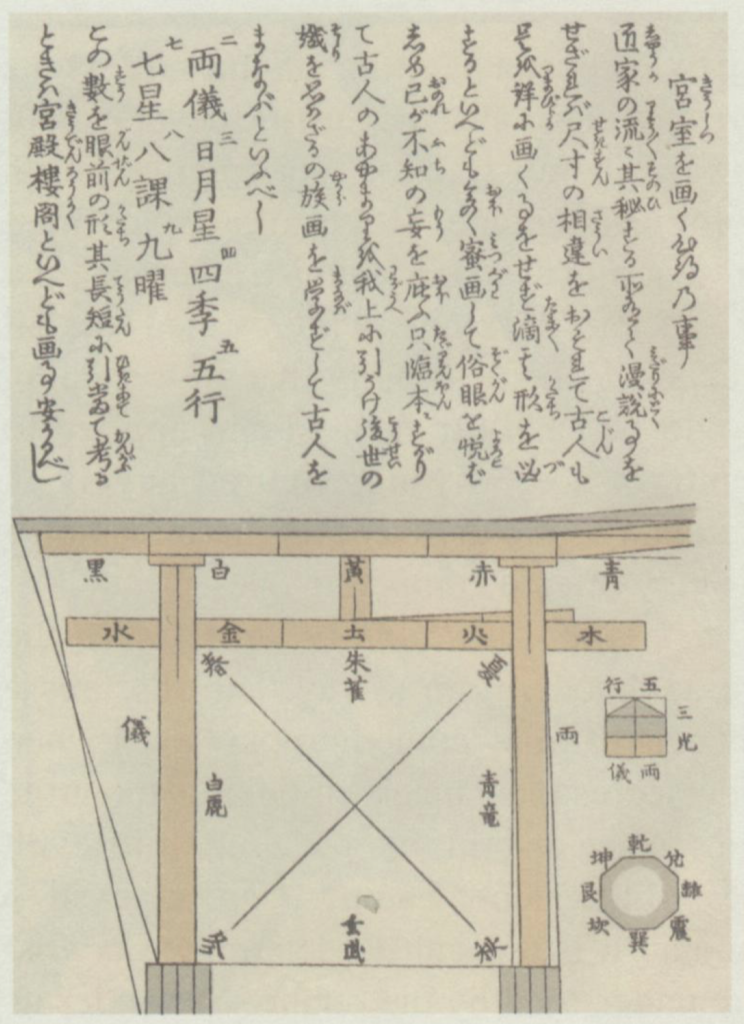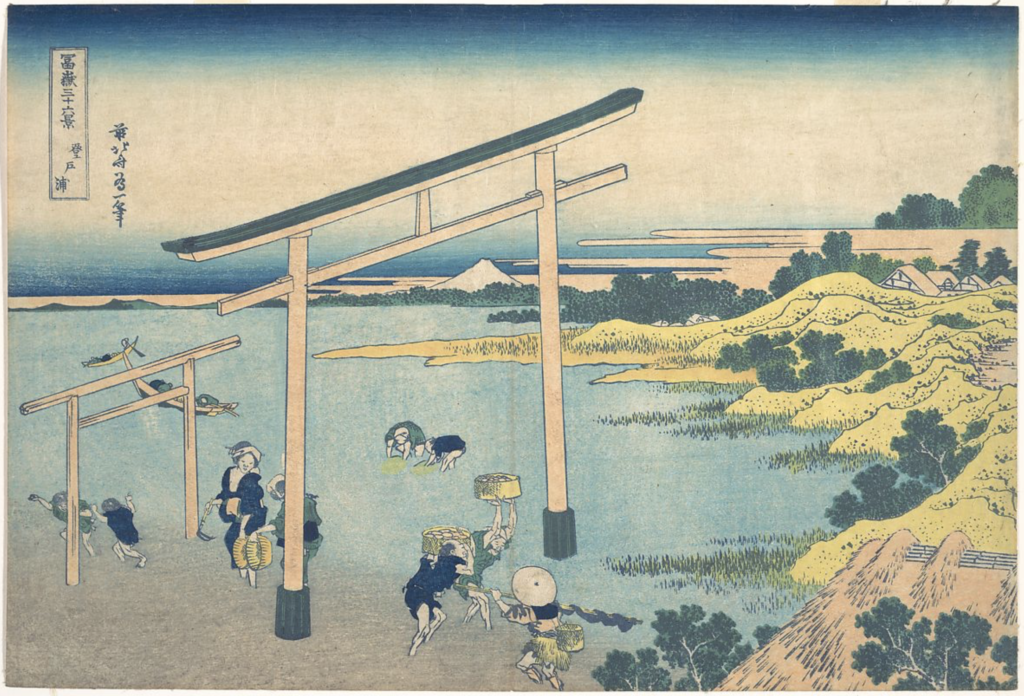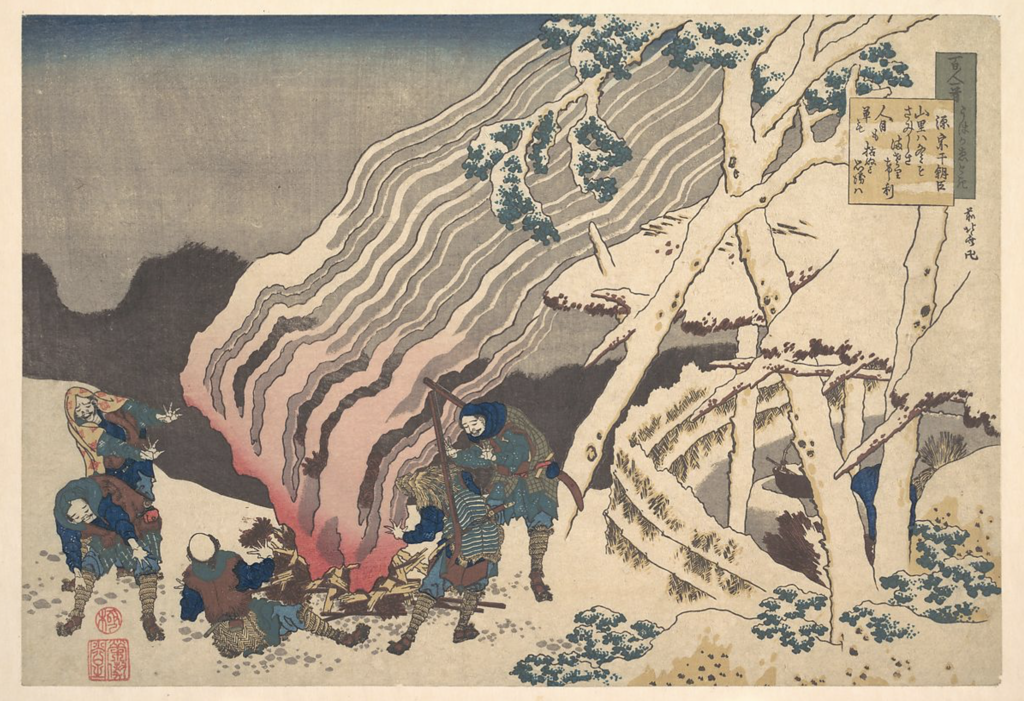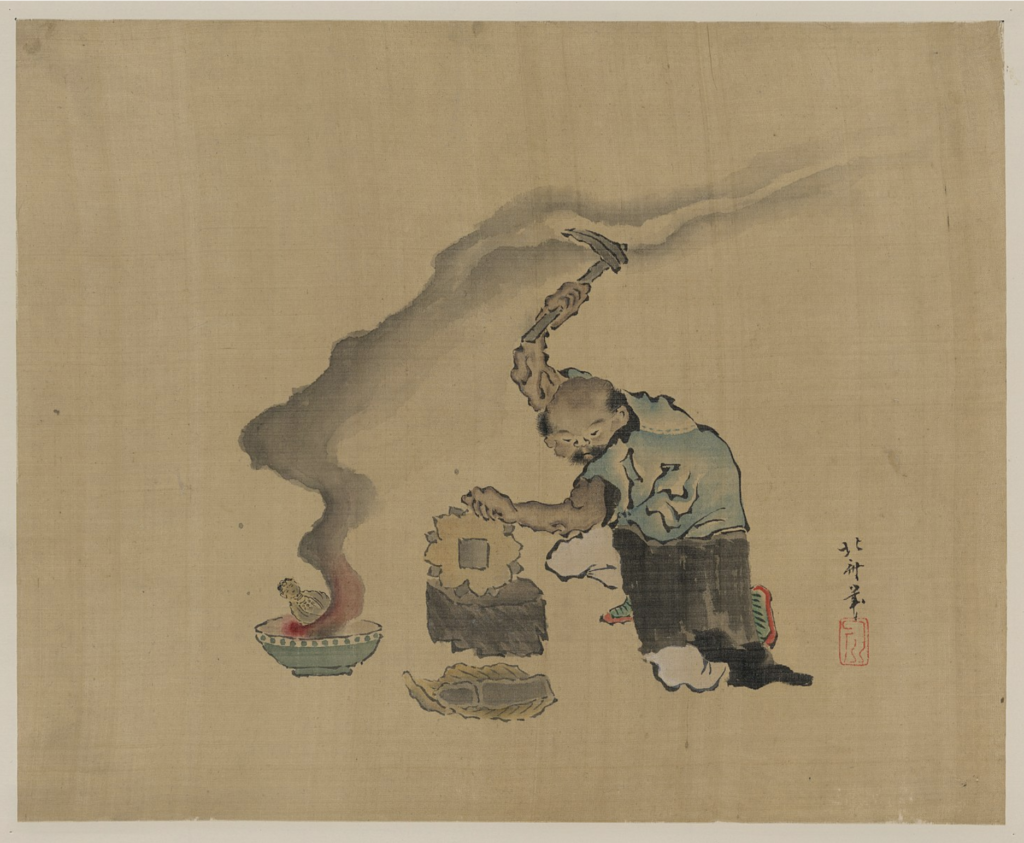Nate Palumbo
December 20, 2021
Exhibition Overview
Represented in his beautiful Ukiyo-e prints, Hokusai stands as a proven master of the five traditional elements of Shintoism (Water, Wood, Fire, Metal, and Earth) which are believed to make-up all aspects of existence within the universe. Much of his artwork captures the innate qualities of the religion’s natural forces which has allowed his pieces to uniquely convey various ideas solely through his representation of each of these elements. Whether it be using water to depict a harmonious scene that gives praise to the Shinto water god or portraying fire in a way that showcases the element’s comforting abilities, the significance of this exhibition lies within Hokusai’s ability to portray the energy, mood, and meaning of the natural components of Shintoism.
Of course, initial suspicions from any critic may challenge the idea that Hokusai readily understood the traditional elements of this religion, however direct evidence from Hokusai himself proves he was a man who was heavily influenced by the philosophical minds of China and the nation’s beliefs in regard to Shintoism. In fact, during the time that Hokusai carried out much of his work, Chinese mystical and cosmological thinking was deeply intertwined with Japanese Culture. In Hokusai’s Random Sketches collection, he directly references The Book of Changes, an ancient Chinese book of divination and prophecy. Within this collection, he tells his readers that drawing a traditional Shinto Shrine is “relatively easy” if one keeps in mind the “the signs of divination of the Book of Changes” and uses them to select the correct proportions of the structure (Guth, 2008). More specifically, Hokusai explains that artists must remember that a Torii’s 5-pieced horizontal beam is representative of the “five elements” of Chinese-Shintoism (Figure 1). With his direct citing of the religion, Hokusai seems to suggest much of his vision of the world was grounded in natural Chinese philosophy and Asian religion. Therefore, it comes without surprise that the influences of Shintoism can even be found in Hokusai’s most famous series of artwork, the Thirty-Six Views of Mount Fuji.
With a total of five primary pieces of artwork representative of the five elements of Shintoism, my exhibition titled, “Hokusai, Master of the Elements,” was constructed over the course of roughly 10 weeks. Each presented image has been obtained from open-access web pages including the Metropolitan Museum of Art and Wikimedia Commons. As for my research, much of the religious information and historical content presented in this exhibition comes from various online encyclopedias, blogs, and scholarly articles. Overall, my exhibition provides the world with the foundation for future research on a largely unexplored topic that looks to highlight the influences of Shintoism on Hokusai’s artwork and his cognitive understanding of the five elements.
As for my educational motivation behind this exhibition, during my preliminary examination of Hokusai’s artwork I was very intrigued by his continual depiction of water within his prints. This subsequently led me to take a more holistic approach to the study of his work and research how Hokusai has utilized the other natural elements of Asian religions within his creations. As a result, my personal interpretation of his artwork caused me to view the underlying importance of my exhibition as a way to showcase a fusion between traditional Chinese-Shinto thought and Hokusai’s Ukiyo-e artwork.
With that being said, my personal inspiration for creating this unprecedented exhibition comes from my particular interest in the beauty of nature and its refreshing qualities. I have always enjoyed real-life photos of nature which initially drew my attention to the various landscape prints we studied at the beginning of this course. Thus, I have found the creation of this exhibition to be extremely rewarding as it has introduced me to a new artistic perspective of the world in which we live.
Figure 1:

Figure 1. Katsushika Hokusai, Torii. C. 1834, Edo Period (1615 – 1868). Ink and color on paper. 9 x 6 1/4 inches. Random Sketches, v. 5. The Metropolitan Museum of Art. The bottommost horizontal beam is representative of the five natural elements of Shintoism (Water, Wood, Fire, Metal, and Earth).
Exhibition
Image 1:

Title: Noboto Bay (Noboto no ura)
Series: Thirty-six Views of Mount Fuji (Fugaku sanjūrokkei)
Creator: Katsushika Hokusai
Medium: Woodblock print; ink & color on paper
Date: 1830 – 1832
Period: Edo Period (1615 – 1868)
Culture: Japan
Dimensions: 9 3/4 x 14 3/8 inches
Repository: The MET (New York, NY)
Classification: Prints
Image Link: https://www.metmuseum.org/art/collection/search/56216
Natural Element: Water
Description: Hokusai captures a glimpse of everyday life in Noboto Bay as people interact with the water element beneath two Shinto shrines. Serving as a gateway to the water, the shrine suggests the bay to be a place of worship for the Shinto water god, guardian of fisherman. With a direct reference to the sacred religion, Hokusai appears to give respect to this deity and while showing appreciation for the gifts in which the water offers to civilization. Under the large Torii, we see a group of fishermen harvesting clams from the shallow bay. As a result, an overwhelming sense of harmony is felt when viewing the print through Hokusai’s portrayal of man working in close proximity with nature. By only taking enough clams to fill a single bucket, the fisherman display their conscientious effort to respect the water element and avoid the exploitation of its resources.
Being a symbol of purity and fertility within the Shinto religion, the ideals of the water element are further emphasized by the thriving waterfront. Along the coastline, we see a plethora of healthy green vegetation that has been nourished by the nearby water. Overall, the flourishing grassing planes accented by the dark green bushes adds to the beauty of the scene while bringing the cherished qualities of the water element to life.
Image 2:

Title: Mishima Pass in Kai Province (Kōshū Mishima goe)
Series: Thirty-six Views of Mount Fuji (Fugaku sanjūrokkei)
Creator: Katsushika Hokusai
Medium: Woodblock print; ink & color on paper
Date: 1830 – 1832
Period: Edo Period (1615 – 1868)
Culture: Japan
Dimensions: 9 5/8 x 14 7/8 inches
Repository: The MET (New York, NY)
Classification: Prints
Image Link: https://www.metmuseum.org/art/collection/search/56346
Natural Element: Wood
Description: Mishima Pass in Kia Province showcases the inherent strength, generosity, and liveliness that the wood element is believed to represent in the Shinto religion. In the foreground, we see a group of men embracing a massive cedar tree in an attempt to measure the tree’s impressive girth. Through the act of hugging, Hokusai creates a scene that represents mankind’s appreciation for the traditional wood element and its valuable uses to the human race. Along with this, the contrast between the small human figures and the monumental tree brings overwhelming power to the element while cementing its spiritual significance.
Furthermore, the aged and roughed bark of the tree adds to the beauty of this earthy feature and emphasizes the ideals wabi-sabi and its appreciation for the imperfection of nature. In the background, we see Japan’s eternal Mount Fuji with a smoky trail circling the volcanic summit. Serving as a gateway to the center of the earth, Hokusai’s depiction of the mountain feels full of potential energy as it waits to burst with the innards of earth’s core. The unwavering presence of both the mountain and tree combine to create a strong sense of stability within print while bringing artistic meaning to the traditional wood element.
Image 3:

Title: Hunters by a Fire in the Snow (Minamoto no Muneyuki ason)
Series: One Hundred Poems Explained by the Nurse (Hyakunin isshu uba ga etoki)
Creator: Katsushika Hokusai
Medium: Woodblock print; ink & color on paper
Date: 1835
Period: Edo Period (1615 – 1868)
Culture: Japan
Dimensions: 9 7/8 x 14 1/2 inches
Repository: The MET (New York, NY)
Classification: Prints
Image Link: https://www.metmuseum.org/art/collection/search/56979
Natural Element: Fire
Description: In Hokusai’s Hunters by a Fire in the Snow he illustrates a story of several struggling hunters as they cluster around a blazing fire in celebration of the element’s warming qualities. Admired by the Shinto religion for its persistence, enthusiasm, and heating ability, the fire element stands as the centerpiece of this energetic print that represents and gives praise to the element’s ability to bring comfort to humans in the most ruthless of circumstances. The muted colors of the frozen white landscape contrast beautifully with the fire’s bright red embers and highlight the natural conflict between fire and snow. Taking a closer look at the fire’s smokey trail, Hokusai creates a feeling of dynamic movement as the hazy plume slithers off into the brisk night sky leaving viewers with a profound sense of hope for the morning sun.
Image 4:

Title: A Man Engaged in Metalwork
Creator: Katsushika Hokusai
Medium: Painting; color on paper
Date: 1790
Period: Edo Period (1615 – 1868)
Culture: Japan
Dimensions: No Information
Repository: Library of Congress
Classification: Painting
Natural Element: Metal
Description: Hokusai’s A Man Engaged in Metalwork gives respect to the metal element for its firm, but also malleable properties. In the image, we see an eldery man who appears to be melting a metal statue in an attempt to recycle the natural element. Through wielding a pickaxe, the man is forcefully breaking down the statue into smaller pieces until they can be heated in the scorching pot in the bottom right of the piece. Aligning harmoniously with the Shinto belief system, this painting breathes life into the religious significance of element for its showcases how metal can be forceful and strong in one phase, by flexible and ductile in another. More specifically, Hokusia depicts a scene regarded by Shintoist as one of the 5 “overcoming interactions” of the natural elements in which fire melts metal though a destructive cycle. With that being said, this painting displays the resilience of the metal element and its honored resusabildy to humans.
Image 5:

Title: South Wind, Clear Sky (Gaifū kaisei) / Red Fuji
Series: Thirty-six Views of Mount Fuji (Fugaku sanjūrokkei)
Creator: Katsushika Hokusai
Medium: Woodblock print; ink & color on paper
Date: 1830 – 1832
Period: Edo Period (1615 – 1868)
Culture: Japan
Dimensions: 9 5/8 x 14 inches
Repository: The MET (New York, NY)
Classification: Prints
Image Link: https://www.metmuseum.org/art/collection/search/36490
Natural Element: Earth
Description: Regarded as a sacred site by Shinto practitioners since at least the 7th century, Hokusai’s depiction of the eternal Mount Fuji in, “Red Fuji,” undoubtedly brings spiritual life to the religion’s earth element, characterized by the qualities of stability and patience. With a radiating red glow and empowering presence that occupies almost half the paper, the grand Mount Fuji captures the very embodiment of the earth’s divine spirit. The monumental quality of the mountain perfectly represents the Shinto belief that the natural features of the earth are the dwelling places of spirits called kami which hold influence over human affairs. Under closer examination, this idea is further highlighted by the unnatural halo of clouds that engulfs the mountain’s peak. This divine arrangement helps to emphasize the significance of the Shinto earth element while fortifying the national importance of this mountain.
Glossary
Ukiyo-e: A genre of Japanese art which flourished during the Edo Period in Japan. Literally meaning, “pictures of the floating World,” the genre’s artists produced woodblock prints and paintings of subjects such as beautiful women, actors, everyday people, and landscapes.
Torii: A traditional gate found at the entrance of or within a Shinto worship place, where it symbolically marks the transition from the mundane to the sacred.
Thirty-Six Views of Mount Fuji: The Thirty-six Views of Mount Fuji (Fugaku Sanjūrokkei) is a series of landscape prints by Hokusai. The series depicts Mount Fuji from different locations and in various seasons and weather conditions.
Book of Changes: The 2,500 year old Yi-jing or I-Ching, translated as the “Book of Changes,” is an ancient Chinese work of divination and prophecy, dating from the fourth century BC. The interpretation of the readings found in the I-Ching is a matter that has been endlessly discussed for over centuries, and many commentators have used the book symbolically, often to provide guidance for moral decision making as informed by Asian religions.
Wabi-Sabi: In traditional Japanese aesthetics, wabi-sabi is a worldview that is centered around the acceptance and appreciation for the imperfection of nature.
Bibliography
Images:
Hokusai, Katsushika. “A Man Engaged in Metalwork, Appears to Be Melting Statues to Reuse the Metal, with a Kitten next to His Left Leg.” Wikimedia Commons, Library of Congress, 1790, Wikimedia Commons, https://commons.wikimedia.org/wiki/File:A_man_engaged_in_metalwork,_appears_to_be_melting_statues_to_reuse_the_metal,_with_a_kitten_next_to_his_left_leg_LCCN2009615300.jpg. Accessed Nov. 2021. Image.
Hokusai, Katsushika. “Hunters by a Fire in the Snow.” The MET, The Metropolitan Museum of Art, 1835, The Metropolitan Museum of Art, New York City, NY, https://www.metmuseum.org/art/collection/search/56979. Accessed Nov. 2021. Image.
Hokusai, Katsushika. “Mishima Pass in Kai Province (Kōshū Mishima Goe).” The MET, The Metropolitan Museum of Art, 1830-32, The Metropolitan Museum of Art, New York City, NY, https://www.metmuseum.org/art/collection/search/56346. Accessed Nov. 2021. Image.
Hokusai, Katsushika. “Noboto Bay (Noboto no ura).” The MET, The Metropolitan Museum of Art, 1830-32, The Metropolitan Museum of Art, New York City, NY, https://www.metmuseum.org/art/collection/search/56216. Accessed Nov. 2021. Image.
Hokusai, Katsushika. “South Wind, Clear Sky (Gaifû Kaisei) / Red Fuji.” The MET, The Metropolitan Museum of Art, 1830-32, The Metropolitan Museum of Art, New York City, NY, https://www.metmuseum.org/art/collection/search/36490. Accessed Nov. 2021. Image.
Hokusai, Katsushika. “Torii.” The MET, The Metropolitan Museum of Art, 1834, The Metropolitan Museum of Art, New York City, NY, https://www.metmuseum.org/art/collection/search/57833. Accessed Nov. 2021. Image.
Texts:
“Bay of Noboto.” Japanese Prints, JapanesePrints.org, 2020 http://japaneseprints.org/hokusai/bay-of-noboto/. Website.
Earhart, Byron H. “Woodblock Prints and Popular Arts.” Mount Fuji: Icon of Japan, 2011, pp. 99–108., https://doi.org/10.2307/j.ctv6wgfmg.17. Online Journal Article.
Guth, Christine M. E. “Hokusai’s Geometry.” Review of Japanese Culture and Society, vol. 20, no. 1, Dec. 2008, pp. 120–132., https://www.jstor.org/stable/42800997. Online Journal Article.
Hammer, Elizabeth. “Shinto: A Japanese Religion.” Asia Society, Asia Society, https://asiasociety.org/education/shinto. Website.
Hirai, Naofusa. “Shintō.” Encyclopedia Britannica, Encyclopedia Britannica, Inc., 1999, https://www.britannica.com/topic/Shinto. Online Encyclopedia.
Mayor, A. Hyatt, and Yasuko Betchaku. “Hokusai.” The Metropolitan Museum of Art Bulletin, vol. 43, no. 1, 1985, p. 1., https://doi.org/10.2307/3263896. Online Journal Article.
Dougill, John. “Water – the Stuff of Life.” Green Shinto, Green Shinto, 16 Apr. 2012, https://www.greenshinto.com/wp/2012/04/16/water-the-stuff-of-life/. Website.
“Wu Xing.” New World Encyclopedia, New World Encyclopedia, https://www.newworldencyclopedia.org/entry/Wu_Xing. Online Encyclopedia.